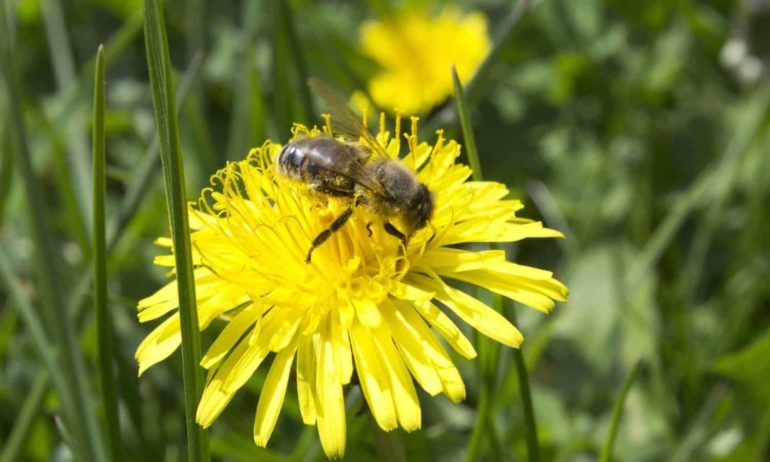The White House Pollinator Health Task Force has laid out a federal strategy plan to protect bees, butterflies, and other pollinators. These species are immensely valuable to our agricultural economy, human health, as well as the overall health of the environment. The Center for Food Safety (CFS) has been working hard on this issue for several years now, filing lawsuits, advocating for stronger policies to protect these species, and spearheading grassroots campaigns. Here are CFS’s top five takeaways from this long-awaited announcement.
1) They can talk the talk, but can they walk the walk?
The White House Task Force (WHTF) announced a number of good ideas, but the plan lacks definitive actions. Its “strategy plan” is largely a plan for communications, outreach, and research—it has very few concrete steps aimed at protecting pollinators in the short-term, especially from the unique risks of systemic, highly persistent insecticides like neonicotinoids. Some of their ambitious goals include:
· Reducing honey bee colony losses during winter to no more than 15 percent within 10 years
· Increasing the monarch butterfly population to 225 million butterflies in the overwintering grounds in Mexico by 2020
· Restoring or enhancing 7 million acres of land for pollinators over the next five years
In theory, this all sounds great (who wouldn’t want reduced honey bee losses and greater monarch numbers?), but we can’t achieve these goals without taking strong action now on pesticides. The next few points explain why.
2) Habitat, habitat, and more habitat
The plan focuses heavily on creating pollinator habitat, but ignores the strong potential for contamination of those areas with bee-toxic pesticides. Government agencies and private corporations can’t just plant more wildflowers and expect pesticides that last for years in soil to simply stop being a problem. For example, the guidelines for creating habitat on federal lands weakly encourage officials to “try to keep portions of pollinator habitat free of pesticide use.” But unless you get rid of pesticides altogether, this simply is not possible. Certain pesticides, like neonicotinoids, are highly toxic, long-lasting, water-soluble, and very mobile—and the White House plan does nothing to prevent them from poisoning future pollinator habitat.
Even if pesticides aren’t used directly on pollinator habitat, there’s still a good chance those plants will become contaminated by toxic pesticides used nearby. As CFS and other groups have consistently pointed out, neonicotinoids can persist for several years after the initial application, and as they break down, the metabolites can actually become more toxic. So while pollinators may have more habitat and forage to look forward to, they’ll enjoy it at their own risk.
3) The U.S. Environmental Protection Agency (EPA) finally admits that neonicotinoids pose unique hazards to bees, but that doesn’t mean they’ll take action.
In the plan, the EPA states, “This pesticide class is differentiated by its unique hazard database for bees, its disposition in the environment, and frequent association with adverse effects incidents, in the United States and elsewhere.” Finally, EPA has come around to what independent, peer-reviewed science has been highlighting for years—and, unfortunately, recognizing these unique risks did not translate into specific, immediate actions to address them. Overall, the WHTF failed to take into account the full weight of scientific evidence indicating that neonicotinoids and other systemic insecticides seriously threaten pollinators and other invertebrates, as well as the broader ecosystems that depend upon them. The plan also ignored extensive new independent science that has demonstrated clear chronic effects on bumblebees, other native bees, and honey bees.
4) Better practices will save the bees.
The WHTF relies heavily on the voluntary implementation of Best Management Practices (BMPs) to reduce adverse impacts of pesticides to pollinators. These mostly revolve around using pesticides “more judiciously,” but there’s a serious problem with that. First and foremost, there is no such thing as “judicious use” of neonicotinoids because their primary use is as a seed coating on commodity crops like corn, soybeans, and wheat. Whole fields are planted with every single seed covered in a neonicotinoid. When it comes down to it, the entire function of a seed coating is to deliver the pesticide to the plant, whether it’s needed or not—there’s nothing judicious about it.
5) Monarchs matter, but not enough to warrant federal protection.
The WHTF plan certainly recognizes the serious threats currently facing monarch butterflies, and specifically highlights the destructive effects of glyphosate-based weedkillers on the milkweed plants essential to the species’s survival. But once again, the plan focuses the majority of its attention on habitat restoration efforts. Sure, improving milkweed habitat will help monarchs, but it really won’t make much of a difference in the end if lawmakers don’t also deal with the agricultural practices responsible for the eradication of milkweed in the first place. Listing monarch butterflies as threatened under the Endangered Species Act (ESA) is the most effective way to ensure their populations rebound to resilient, healthy levels.






